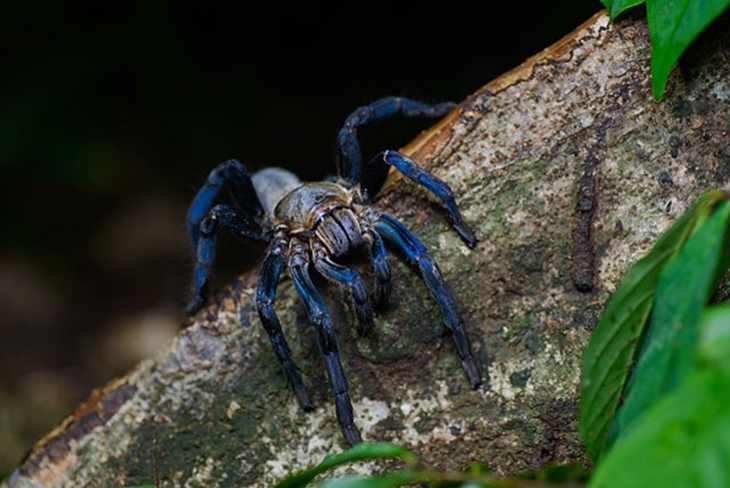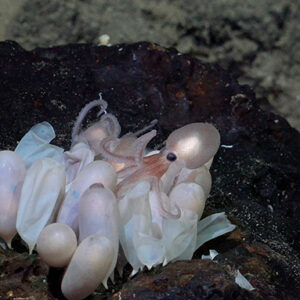
This amazing arachnid is a true marvel of nature. Even those with an aversion to spiders would find it challenging not to be captivated by a tarantula that defies conventional expectations by flaunting an electric blue appearance as if it’s sporting a trendy hair gel.
The journey to uncover this exotic tarantula’s existence was a saga filled with fascination and humanitarian purpose. It wasn’t just a scientific endeavor; it was also driven by a noble cause.
This narrative unfolds in the heart of a mangrove forest on Thailand, where the astonishing discovery was made. The leader of this scientific expedition, Narin Chomphuphuang, was joined by the popular Thai YouTuber explorer, JoCho Sippawat.
What started as a scientific quest eventually become a source of national excitement, thanks to the sensational discovery of the iridescent spider. This prompted the team to take an unconventional path.
In a unique and groundbreaking move, they decided to auction off the rights to bestow the iridescent spider with its official scientific name. This innovative approach was not merely for academic purposes but served as dual role. The primary aim was to raise both funds and awareness to support the cause of JoCho Sippawat’s people.
JoCho Sippawat hails from the Lahu indigenous group, which are scattered across Northern Thailand and Southern China. While officially recognized by the latter, the Thai government has denied their existence, subjecting them to mistreatment, according to the International Working Group for Indigenous Affairs (IWGIA).
An important footnote in this story was when GNN reported last year when JoCho Sippawat stumbled upon a tarantula inhabiting the hollow of a bamboo tree. This was a monumental discovery in the field of arachnology, as not only was it a new species, but it also represented a new genus. Among the vast arachnid family of over a thousand members, none have ever been documented residing within bamboo.
Now, the official name for the spider is Chilobrachys natanicharum, which pays tribute to two Thai businessmen who secured the honor through their successful bid in the naming auction.
One of the most intriguing aspects of this exceptional tarantula is its distinct blue coloration that adorns patches all around the front of its body. This is a particularly perplexing phenomenon because, unlike chameleons that utilize pigments to create their vivid hues, the tarantula’s vibrant appearance is a result of its unique hair structure.
The spider’s hair absorbs certain wavelengths of light while reflecting others, creating a striking interplay of colors. It is this complex interplay that make blue animals an extraordinary rarity.
Mr. Chomphuphuang writes in the introduction of a study describing the species, “The enchanting phenomenon of blue coloration in animals arises from the fact that blue is one of the rarest colors found in nature, and it is a structural color that is produced by the arrangement of biological photonic nanostructures, rather than pigments.”
“C. natanicharum has unique coloration due to the presence of two types of hair: metallic-blue and violet ones. The color depends on the ratio of the two hair colors,” they wrote in the journal ZooKeys.
“To appear blue, an object needs to absorb very small amounts of energy while reflecting high-energy blue light,” which is challenging, Chomphuphuang told CNN.
Although scientific study of this tarantula delves into the fine details of taxonomy and aims to establish its rightful place in the genus, it leaves an intriguing question unanswered. Why would an ambush predator, which typically relies on blending with its surroundings, exhibit iridescent blue coloration in a jungle environment?
In the animal kingdom, bright colors are often deployed as a mating strategy. However, observations revealed that the most vividly colored tarantulas were the young, juvenile males and females. These stunning blue hues do not seem to be related to mating behavior.
Adding to the enigma is the tarantula’s choice of habitat. While most tarantulas are either arboreal or terrestrial, this unique specimen was discovered by the research team within the hollow of a mangrove tree located in a mangrove swamp during low tide. This intriguing behavior suggests a potential aquatic dimension to its lifestyle, which raises even more questions.
Considering the conservation status of southern Thailand’s mangrove ecosystems, it is highly likely that this electric blue tarantula represents one of the rarest of its kind, adding to the mystique and allure. The story of Chilobrachys natanicharum stands as a testament to the wonders of the natural world, continuing to amaze and mystify even the most seasoned scientists and enthusiasts alike.
What are your thoughts? Please comment below and share this news!
True Activist / Report a typo


